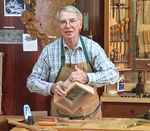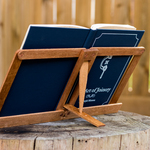We may receive a commission when you use our affiliate links. However, this does not impact our recommendations.
 The Classic Maloof Joint and Hal Taylor’s Modification
The Classic Maloof Joint and Hal Taylor’s Modification
Sam Maloof is a midcentury craftsman most famously known for his sculptural chairs. This is evident in the rounded corners, molded seats, and curved arms and backrests. His joinery also embodied this sculptural motif. I recently took a trip to Iowa to build a Maloof inspired sculpted rocker with my mentor, Tim Fuller. While I implemented some design and joinery modifications, the spirit of Sam Maloof was still very present in my the rocking chair I built. Let’s explore the Maloof Joint a little further.
Construction
The Maloof Joint is a three-sided (two-sided on the back legs of the rocker) housed tongue and groove. Maloof used a ¼” tongue and groove. In my case, I used a ½” tongue and groove. Craftsman, Hal Taylor, adopted this modification to increase glue surface and strengthen the leg joints, thereby eliminating the need for screws. I liked this idea so I’ll be demonstrating this modification on a mock-up of the front leg. 
Hal Taylor’s version of the Maloof Joint is a ½” housed tongue and groove.
I used two commonly available router bits to make this joint. To make the tongue portion I used a 1-½” diameter router bit with a ½” diameter bearing (Woodline WL-1225-7). This creates a ¾” radius at the corners of the rabbet portion of the tongue. To match that radius, I’m using a ¾” round-over bit at the corners of the leg (Woodline WL-1054).
The first thing I did was create a rectangular groove in the 1-⅜” thick seat mock-up. The rectangular groove measured 1-⅞” x 1”. Material thickness and cut dimensions are arbitrary and simply stated to give dimensionality and proportionality. This was done with a flat grind blade on the table saw with the crosscut sled.
Cutting a 1-⅞” x 1” rectangular groove on the table saw with a crosscut sled
To create the housed tongue I used a 1-½” diameter rabbet bit with a ½” diameter bearing. I like using the router table but I know plenty of people that do this operation with a handheld router in a horizontal position to increase visibility. I felt safer doing it on the router table. Just make sure this cut is done incrementally to prevent tearout. I raised the bit so that the end result would be a ¾” wide tongue. Also, notice the backer block clamped to the workpiece at the exit of the cut. This also helped to prevent tearout.
Using the 1-½” diameter rabbet bit with a ½” diameter bearing to created the housed tongue with ¾” radius corners.
Once I made the tongue on the seat mock-up, I needed to size my leg blank to fits snugly between rabbeted portion of the tongue. This is a simple cut on the table saw. You’ll want to error on the side of slightly larger so that you can sneak up on the fit. This is some you don’t want to be too loose.
Leg blank cut width to fit snugly between the rabbeted portion of the tongue.
Next, I machined the groove portion in the leg blank. I went back to the table saw with a flat grind blade and my crosscut sled. Since the tongue is ½” deep and ¾” wide, the groove is cut to a depth of ½” and a width of ¾” to match. You’ll want a friction fit so make sure you’re going back to the seat blank to check the fit.
Machining the ½” deep groove on three sides of the leg blank.
Checking for a friction fit between the leg and seat blank.
Once you get a nice friction fit between the leg and seat blank, you’ll need to round over the corners with ¾” round-over bit in the router table. The joint should go together with a couple of light taps with a mallet. Remember, this is just the joinery side of things. There’s a ton of shaping, sculpting, and blending that needs to be done. But that’s a whole different topic. 
Rounding over the corners of the leg blank with a ¾” round-over bit.
The completed joint should fit snugly with a couple of light taps with a mallet.
The sculpted leg and seat next to the mock-up.
What about the 5 degree splay on the back leg?
The back legs of Sam’s rockers have a 5 degree inward splay. In order to create this splay, Sam developed matching tapered rabbet bits with tapered bearings. Woodline USA is the official manufacturer for Sam Maloof’s router bits.
A diagram of Sam Maloof’s router bits (WL-6220) made by Woodline USA.
I chose to incorporated another one of Hal Taylor’s modifications. Rather than using Sam’s router bits, Hal attaches a 5 degree adder block/wedge to create the splayed legs. This means you’ll be able to create the joint for the back legs using the same method to make the joint for the front legs. This seemed like an easy modification without compromising the spirit of the Maloof Joint. 
The back legs are splayed in at 5 degrees.
Cutting the groove in the back legs of the rocker a crosscut sled. Notice angle of the leg due to a 5 degree adder block/wedge.
The Maloof Joint on the back leg is machined perpendicular to the chair seat with the use of a 5 degree adder block/wedge.
A completed Maloof inspired sculpted rocker.
Here are some supplies and tools we find essential in our everyday work around the shop. We may receive a commission from sales referred by our links; however, we have carefully selected these products for their usefulness and quality.
















